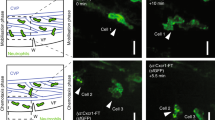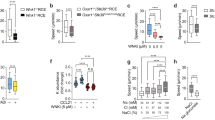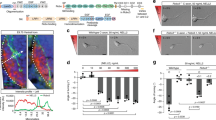Abstract
Migration is a basic feature of many cell types in a wide range of species1. Since the 1800s, cell migration has been proposed to occur in the nervous and immune systems2,3, and distinct molecular cues for mammalian neurons and leukocytes have been identified. Here we report that Slit, a secreted protein previously known for its role of repulsion in axon guidance and neuronal migration, can also inhibit leukocyte chemotaxis induced by chemotactic factors. Slit inhibition of the chemokine-induced chemotaxis can be reconstituted by the co-expression of a chemokine receptor containing seven transmembrane domains and Roundabout (Robo), a Slit receptor containing a single transmembrane domain. Thus, there is a functional interaction between single and seven transmembrane receptors. Our results reveal the activity of a neuronal guidance cue in regulating leukocyte migration and indicate that there may be a general conservation of guidance mechanisms underlying metazoan cell migration. In addition, we have uncovered an inhibitor of leukocyte chemotaxis, and propose a new therapeutic approach to treat diseases involving leukocyte migration and chemotactic factors.
This is a preview of subscription content, access via your institution
Access options
Subscribe to this journal
Receive 51 print issues and online access
$199.00 per year
only $3.90 per issue
Buy this article
- Purchase on Springer Link
- Instant access to full article PDF
Prices may be subject to local taxes which are calculated during checkout




Similar content being viewed by others
References
Devreotes, P. N. & Zigmond, S. H. Chemotaxis in eukaryotic cells: a focus on leukocytes and Dictyostelium. Annu. Rev. Cell Biol. 4, 649–686 (1988).
McCutcheon, M. Chemotaxis in leukocytes. Physiol. Rev. 26, 319–336 (1946).
Bentivoglio, M. & Mazzarello, P. The history of radial glia. Brain Res. Bull. 49, 305–315 (1999).
Springer, T. A. Traffic signals for lymphocyte recirculation and leukocyte emigration: the multistep paradigm. Cell 76, 301–314 (1994).
Murphy, P. M. The molecular biology of leukocyte chemoattractant receptors. Annu. Rev. Immunol. 12, 593–633 (1994).
Baggiolini, M. Chemokines and leukocyte traffic. Nature 392, 565–568 (1998).
Luster, A. D. Chemokines—chemotactic cytokines that mediate inflammation. N. Engl. J. Med. 338, 436–445 (1998).
Cyster, J. G. Chemokines and cell migration in secondary lymphoid organs. Science 286, 2098–2102 (1999).
Campbell, J. J. & Butcher, E. C. Chemokines in tissue-specific and microenvironment-specific lymphocyte homing. Curr. Opin. Immunol. 12, 336–341 (2000).
Rakic, P. Principles of neural cell migration. Experientia 46, 882–891 (1990).
Hatten, M. E. & Heintz, N. in Fundamentals of Neuroscience (ed. Zigmond, M.) 451–479 (Academic, New York, 1998).
Rice, D. S. & Curran, T. Mutant mice with scrambled brains: understanding the signaling pathways that control cell positioning in the CNS. Genes Dev. 13, 2758–2773 (1999).
Nusslein-Volhard, C., Wieschaus, E. & Kluding, H. Mutations affecting the pattern of the larval cuticle in Drosophila melanogaster. I. Zygotic loci on the second chromosome. Roux's Arch. Dev. Biol. 193, 267–282 (1984).
Rothberg, J. M., Hartley, D. A., Walther, Z. & Artavanis-Tsakonas, S. slit: an EGF-homologous locus of D. melanogaster involved in the development of the embryonic central nervous system. Cell 55, 1047–1059 (1988).
Kidd, T., Bland, K. S. & Goodman, C. S. Slit is the midline repellent for the Robo receptor in Drosophila. Cell 96, 785–794 (1999).
Brose, K. et al. Evolutionary conservation of the repulsive axon guidance function of Slit proteins and of their interactions with Robo receptors. Cell 96, 795–806 (1999).
Li, H. S. et al. Vertebrate Slit, a secreted ligand for the transmembrane protein roundabout, is a repellent for olfactory bulb axons. Cell 96, 807–818 (1999).
Wang, K. H. et al. Purification of an axon elongation- and branch-promoting activity from brain identifies a mammalian Slit protein as a positive regulator of sensory axon growth. Cell 96, 771–784 (1999).
Wu, W. et al. Directional guidance of neuronal migration in the olfactory system by the secreted protein Slit. Nature 400, 331–336 (1999).
Hu, H. Chemorepulsion of neuronal migration by Slit2 in the developing mammalian forebrain. Neuron 23, 703–711 (1999).
Zhu, Y., Li, H. S., Zhou, L., Wu, J. Y. & Rao, Y. Cellular and molecular guidance of GABAergic neuronal migration from the striatum to the neocortex. Neuron 23, 473–485 (1999).
Yuan, W. et al. The mouse Slit family: secreted ligands for Robo expressed in patterns that suggest a role in morphogenesis and axon guidance. Dev. Biol. 212, 290–306 (1999).
Collins, S. J., Fuscetti, F. W., Gallagher, R. E. & Gallo, R. C. Normal functional characteristics of cultured human promyelocytic leukemia cells (HL60) after induction of differentiation by dimethylsulfoxide. J. Exp. Med. 149, 969–974 (1979).
Kidd, T. et al. Roundabout controls axon crossing of the CNS midline and defines a novel subfamily of evolutionarily conserved guidance receptors. Cell 92, 205–215 (1998).
Zallen, J. A., Yi, B. A. & Bargmann, C. I. The conserved immunoglobulin superfamily member SAX-3/Robo directs multiple aspects of axon guidance in C. elegans. Cell 92, 217–227 (1998).
Krump, E., Sanghera, J. S., Pelech, S. L., Furuya, W. & Grinstein, S. Chemotactic peptide N-formyl-Met-Leu-Phe activation of p38 mitogen-activated protein kinase (MAPK) and MAPK-activated protein kinase-2 in human neutrophils. J. Biol. Chem. 272, 937–944 (1997).
Downey, G. P. et al. Importance of Mek in neutrophil microbicidal responsiveness. J. Immunol. 160, 434–443 (1998).
O'Brien, P. J. Superoxide production. Methods Enzymol. 105, 370–379 (1984).
Smith, C. A. et al. Poxvirus genomes encode a secreted, soluble protein that preferentially inhibits beta chemokine activity yet lacks sequence homology to known chemokine receptors. Virology 236, 316–327 (1997).
Kledal, T. N. et al. A broad-spectrum chemokine antagonist encoded by Kaposi's sarcoma-associated herpes virus. Science 277, 1656–1659 (1997).
Acknowledgements
The amount of data presented and the number papers cited have been limited by space constraints. We are grateful to X. He for help with FACS; to W. Smith for providing us with the HL60 cell line; to the NIH for grant support (to J.Y.W., L.F. and Y.R.); to the John Merck fund, the Klingenstein foundation, and the Leukemia Society of America for scholar awards (to Y.R. and J.Y.W.).
Author information
Authors and Affiliations
Corresponding author
Rights and permissions
About this article
Cite this article
Wu, J., Feng, L., Park, HT. et al. The neuronal repellent Slit inhibits leukocyte chemotaxis induced by chemotactic factors. Nature 410, 948–952 (2001). https://doi.org/10.1038/35073616
Received:
Accepted:
Issue Date:
DOI: https://doi.org/10.1038/35073616
This article is cited by
-
Identification of direct connections between the dura and the brain
Nature (2024)
-
Targeting Redundant ROBO1 and SDF-1 Pathways Prevents Adult Hemangioblast Derived-EPC and CEC Activity Effectively Blocking Tumor Neovascularization
Stem Cell Reviews and Reports (2023)
-
The principles of directed cell migration
Nature Reviews Molecular Cell Biology (2021)
-
Slit2 is a potential biomarker for renal impairment in systemic lupus erythematosus
Clinical and Experimental Medicine (2021)
-
Neuronal guidance proteins in cardiovascular inflammation
Basic Research in Cardiology (2021)
Comments
By submitting a comment you agree to abide by our Terms and Community Guidelines. If you find something abusive or that does not comply with our terms or guidelines please flag it as inappropriate.



